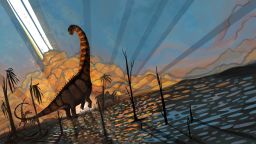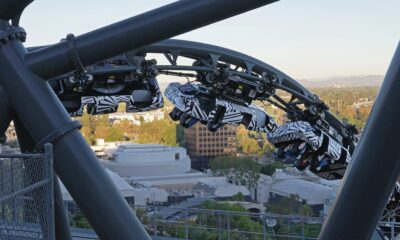Science
Scientists Uncover Secrets of Dinosaur ‘Mummies’ in Wyoming

In a groundbreaking study, researchers have revealed that what were thought to be well-preserved dinosaur skin specimens from the Lance Formation in eastern Wyoming are actually remarkable clay casts. This finding sheds light on the preservation process of dinosaur fossils and enhances understanding of their physical attributes.
The Lance Formation, a well-known fossil-rich area, spans less than 10 kilometers (6 miles) and has yielded numerous impressive dinosaur specimens. Among these is the duck-billed dinosaur, Edmontosaurus annectens, first discovered in the early 1900s by fossil hunter Charles Sternberg. His discoveries included two remarkably intact skeletons featuring what appeared to be large patches of skin with visible scales and a fleshy crest along the neck.
The recent research, led by paleontologist Dr. Paul Sereno from the University of Chicago, revisits these historical finds and aims to clarify the term “dinosaur mummy.” Sereno noted that while Osborn acknowledged in 1912 that the specimens did not contain actual dehydrated skin, the precise nature of their preservation remained a mystery for over a century.
Unveiling the Clay Mask
In the study, published in Science in March 2024, Sereno and his collaborators employed advanced techniques including CT scanning, 3D imaging, and X-ray spectroscopy to analyze two Edmontosaurus mummies they unearthed in 2000 and 2001. These included a juvenile and a young adult, both of which displayed preserved features in three-dimensional poses.
Their exhaustive testing revealed a thin layer of clay, measuring less than one-hundredth of an inch thick, that had formed over the dinosaurs’ skin. Sereno remarked on the astonishing realism of the clay impression, which he prefers to term “rendering” for its precision in capturing the dinosaurs’ outer morphology.
The study outlines the environmental conditions necessary for such preservation. During the Late Cretaceous Period, Edmontosaurus thrived in a climate characterized by cycles of drought and monsoon rains. The original mummy found by Sternberg likely perished during a drought, followed by a flash flood that buried the remains in sediment. As the carcasses decayed, a film of bacteria attracted surrounding clay, creating a durable mask that preserved fine details like scales and spikes long after soft tissues had disintegrated.
Insights into Dinosaur Anatomy
This research not only resolves the mystery surrounding the “mummy” designation but also provides a detailed reconstruction of Edmontosaurus. The dinosaur, capable of reaching lengths exceeding 12 meters (40 feet), was characterized by a fleshy crest and a row of spikes along its tail. The clay mask revealed that the creature possessed hooves, marking it as the oldest land animal with this trait and the first known hooved reptile. Sereno humorously noted, “Sorry, mammals, you didn’t invent it,” referencing the long-held belief that hooves were exclusive to mammals.
Experts in the field emphasized the significance of this research. Dr. Anthony Martin, a professor at Emory University, highlighted that clay minerals can accurately replicate biological surfaces, which is critical for understanding how these fossils form. Dr. Stephanie Drumheller-Horton from the University of Tennessee, Knoxville, pointed out that while dinosaur mummies have fascinated scientists for over a century, understanding the conditions leading to their fossilization is crucial for future discoveries.
This study not only enhances knowledge about the physical appearance of Edmontosaurus but also sets a foundation for identifying and analyzing future fossil finds, ensuring that the legacy of these ancient creatures continues to evolve through scientific inquiry.
-

 World1 week ago
World1 week agoMass Production of F-35 Fighter Jet Drives Down Costs
-

 World1 week ago
World1 week agoGlobal Air Forces Ranked by Annual Defense Budgets in 2025
-

 Top Stories1 week ago
Top Stories1 week agoNew ‘Star Trek: Voyager’ Game Demo Released, Players Test Limits
-

 Top Stories1 week ago
Top Stories1 week agoDirecTV to Launch AI-Driven Ads with User Likenesses in 2026
-

 Lifestyle7 days ago
Lifestyle7 days agoDiscover Reese Witherspoon’s Chic Dining Room Style for Under $25
-

 World1 week ago
World1 week agoElectrification Challenges Demand Advanced Multiphysics Modeling
-

 Science1 week ago
Science1 week agoTime Crystals Revolutionize Quantum Computing Potential
-

 Science7 days ago
Science7 days agoWaning Crescent Moon: What to Expect on October 17
-

 Entertainment1 week ago
Entertainment1 week agoFreeport Art Gallery Transforms Waste into Creative Masterpieces
-

 Health7 days ago
Health7 days agoGavin Newsom Critiques Trump’s Health and National Guard Plans
-

 Science1 week ago
Science1 week agoTulsa Students Inspire New Book on Ralph Ellison’s Legacy
-

 Entertainment1 week ago
Entertainment1 week agoFast & Furious Coaster Hits the Track at Universal Studios









